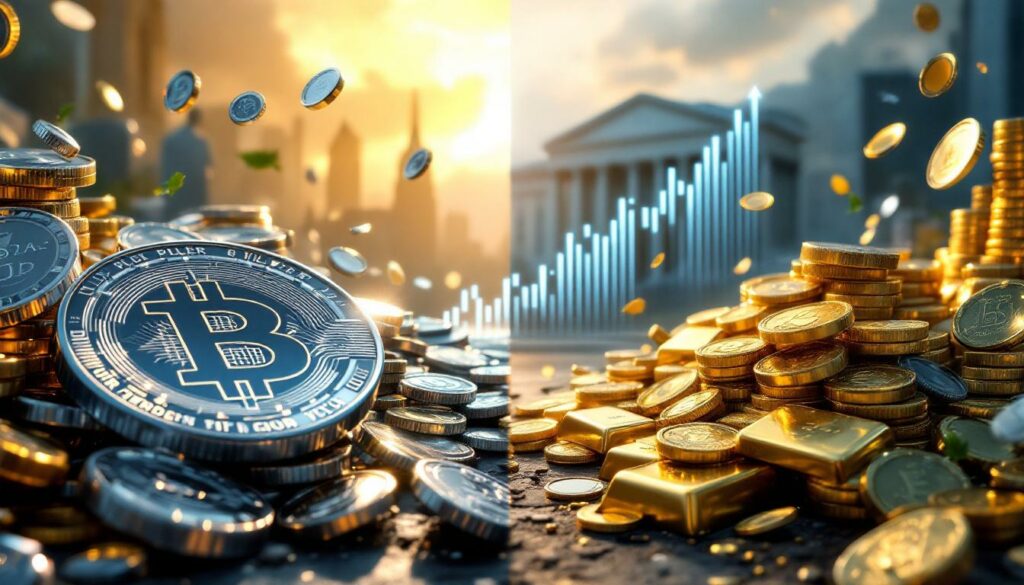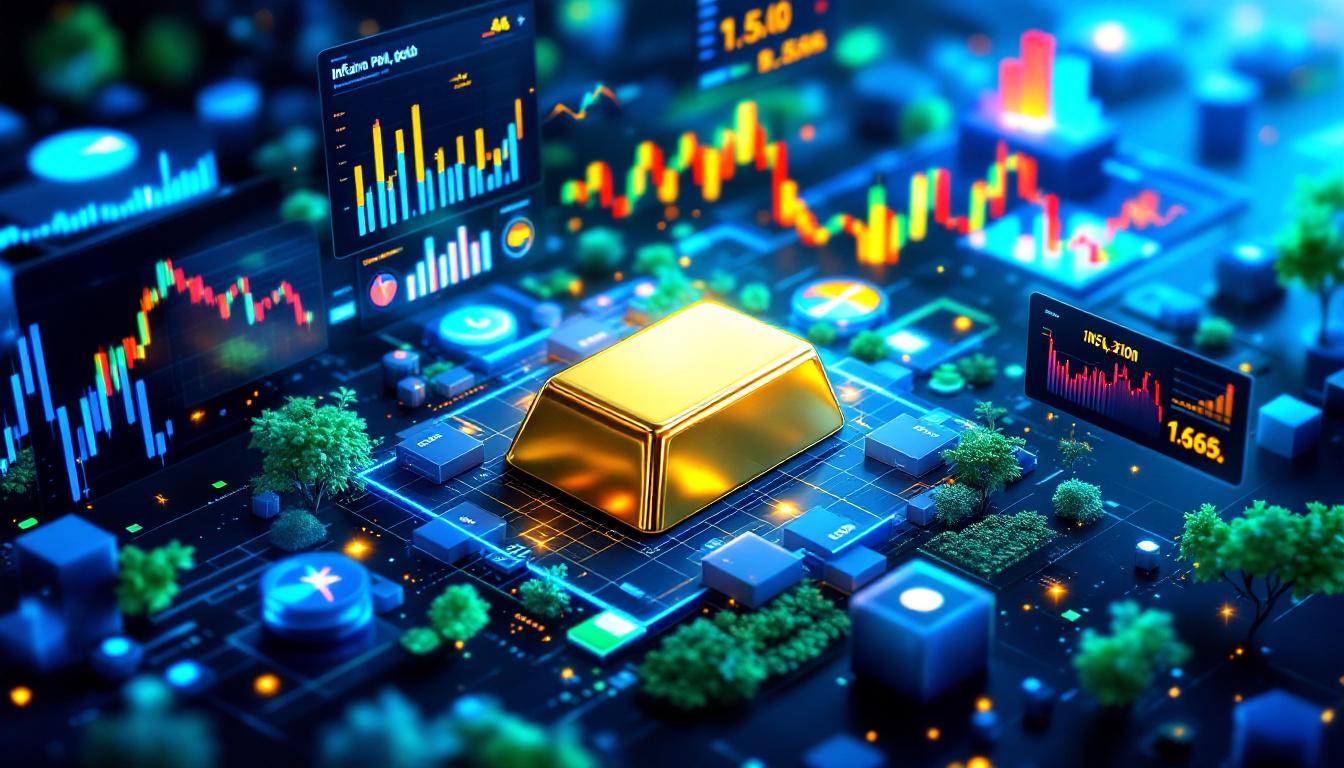What's Driving the Recent Surge in Silver Prices?
The precious metals market has experienced a remarkable transformation in recent months, with silver breaking through significant psychological barriers. Silver prices have surged past $35 per ounce and approached $36, representing one of the strongest rallies since the 2020-2021 period. This technical breakout suggests substantial momentum as new support levels establish themselves in the market.
"The technical indicators for silver are showing a classic breakout pattern that typically precedes extended upward price movement," notes industry analysts tracking the metal's performance through June 2025.
The Breaking of Key Price Resistance Levels
Silver's impressive rally beyond the $35 per ounce mark represents a critical technical breakout that has caught the attention of institutional investors. This price action follows months of consolidation where silver repeatedly tested but failed to break through this resistance level. When such long-established resistance finally gives way, it often signals a fundamental shift in market sentiment.
The breakout has been characterized by increasing trading volumes and declining silver inventories on major exchanges, further validating the strength of this move. Technical analysts point to the potential for silver to establish new support at previous resistance levels, creating a foundation for further gains.
"More spending, more government debt, more conflict… these are the things important to the precious metals space," explains Nicholas Tartaglia, highlighting the fundamental factors driving this technical price action.
Geopolitical Tensions Creating Safe-Haven Demand
The escalation of multiple global conflicts has created a perfect storm for precious metals markets. Recent tensions between Israel and Palestine have intensified, while the Russia-Ukraine conflict continues with no resolution in sight. Additionally, emerging flashpoints including India-Pakistan relations and growing concerns about Taiwan's security have collectively driven investors toward traditional safe-haven assets.
These geopolitical tensions have historically correlated strongly with precious metals performance. According to World Gold Council data, gold and silver typically outperform most financial assets during periods of heightened geopolitical risk, with average gains of 6.4% during crisis events compared to broader market declines.
The convergence of multiple simultaneous conflicts creates a multiplicative effect on safe-haven demand rather than merely an additive one. When investors perceive threats across multiple regions, the psychological impact drives disproportionately larger capital flows into tangible assets like silver and gold.
Government Fiscal Policies and Debt Expansion
Recent legislative actions have sparked significant concern about fiscal sustainability. The controversial "Big Beautiful Bill" added approximately $2.5 trillion to the U.S. national debt without corresponding revenue increases. This massive expansion of government spending without fiscal offsets creates the textbook environment for inflationary pressure.
The U.S. Debt-to-GDP ratio has reached approximately 135% as of Q1 2025, according to IMF data, placing it in territory historically associated with reduced economic growth potential and increased currency risk. This level of indebtedness typically precedes periods of financial repression where governments must resort to inflation to manage unsustainable debt loads.
As Milton Friedman famously observed, "Inflation is taxation without legislation." This insight remains profoundly relevant today as governments worldwide attempt to navigate unprecedented debt burdens through monetary rather than fiscal solutions.
How Do Global Debt Crises Affect Precious Metal Prices?
The relationship between government debt and precious metals performance has been well-documented throughout financial history. When sovereign debt reaches unsustainable levels, governments typically face limited options: default, austerity, or currency devaluation through inflation. The latter has historically been the politically expedient choice, creating powerful tailwinds for precious metals.
The Inflation-Debt Connection
When governments increase spending without raising taxes, they typically resort to monetary expansion or borrowing. This creates an environment where inflation becomes the primary mechanism for managing unsustainable debt loads. While this reduces the real value of government obligations, it simultaneously erodes the purchasing power of citizens' savings and income.
This monetary degradation directly benefits hard assets like gold and silver that maintain purchasing power over time. Unlike financial assets that represent claims on future cash flows (which become less valuable in inflationary environments), precious metals retain their fundamental properties regardless of monetary conditions.
Recent BIS (Bank for International Settlements) research indicates that inflation cycles have compressed from historical 10-year patterns to more frequent 3-5 year cycles. This acceleration suggests structural economic issues that conventional monetary policy cannot easily resolve.
"When governments choose to spend without limits, citizens must choose assets without counterparty risk. This fundamental reality hasn't changed throughout 5,000 years of recorded economic history." — Nicholas Tartaglia
Central Bank Rate Policies and Their Impact
Central banks worldwide have demonstrated a pattern of pausing or lowering interest rates despite persistent inflation concerns. This policy approach signals an implicit prioritization of debt management over inflation control. When central banks maintain negative real interest rates (nominal rates below inflation), they effectively transfer wealth from savers to borrowers—with governments being the largest borrowers.
The European Central Bank and Federal Reserve meeting minutes from 2024-2025 reveal increasing concern about debt serviceability if rates remain elevated. This institutional bias toward lower rates creates an environment where hard assets outperform financial instruments that depend on positive real yields.
The frequency of inflationary cycles appears to be accelerating, with shorter periods between monetary expansion phases. These compressed cycles create market volatility that drives investors toward precious metals as stability anchors during periods of monetary uncertainty.
European Military Re-Industrialization Effects
Europe's pivot toward military re-industrialization as an economic stimulus strategy mirrors historical patterns from the early 20th century. According to the 2024 SIPRI Report, European military spending increased by approximately 15% year-over-year, representing the largest percentage increase in decades.
This approach typically leads to increased government spending without corresponding productivity improvements in the broader economy. Military expenditures, while potentially necessary for security reasons, generally do not generate the economic multiplier effects of other forms of infrastructure investment.
The historical parallel to pre-WWII European rearmament is particularly noteworthy. That period similarly saw massive government spending programs focused on military capacity, which ultimately contributed to currency debasement and inflation in subsequent years.
Why Are Silver and Gold Considered Wealth Protection Assets?
Precious metals have maintained their status as wealth preservation vehicles across centuries and civilizations. This enduring role stems from their unique characteristics that differentiate them from government-issued currencies and financial instruments.
Limited Supply vs. Unlimited Currency Creation
Unlike fiat currencies that can be created through government printing or digital expansion, precious metals have finite supplies that cannot be artificially expanded. Annual gold production averages approximately 3,500 tons according to the World Gold Council, representing a tiny fraction of the existing supply and limiting annual supply growth to roughly 1.5-2%.
Silver supply dynamics are similarly constrained, with much of its mining occurring as a byproduct of other metal extraction rather than from dedicated silver mines. This natural limitation creates inherent value preservation capabilities during periods of currency debasement.
The contrast between precious metals and fiat currencies becomes most apparent during economic crises when central banks typically respond with dramatic monetary expansion. While currency supply can increase by double-digit percentages during emergency interventions, precious metals supply remains virtually unchanged.
Cultural Shift Toward Precious Metals Awareness
A notable cultural transformation is occurring as mainstream media personalities, investment advisors, and high-profile individuals increasingly advocate for precious metals ownership. This mainstreaming of gold and silver as legitimate investment assets represents a significant shift in public perception.
Media personalities like Pierce Morgan have advertised gold and silver on mainstream television programs, introducing precious metals concepts to audiences that previously had minimal exposure to alternative investment ideas. This broadening awareness typically precedes larger capital flows into the sector.
Financial advisors who previously dismissed precious metals are increasingly recommending allocations of 5-15% according to CFP Board Guidelines, recognizing the portfolio diversification benefits during periods of monetary uncertainty.
Silver's Unique Position as "Poor Man's Gold"
Silver offers accessibility advantages compared to gold, with its lower price point allowing broader market participation. As Nicholas Tartaglia notes, "Silver is the poor man's gold… still a really big buy" for investors seeking inflation protection without committing the larger capital required for gold ownership.
Despite recent price increases, silver remains relatively affordable compared to historical ratios with gold. The gold-silver ratio insights have historically averaged between 40:1 and 60:1 over centuries, though it has experienced significant fluctuations in modern markets. As of June 2025, the ratio stands at approximately 75:1 according to live precious metal prices, suggesting silver may be undervalued relative to its historical relationship with gold.
Silver's dual role as both monetary metal and industrial commodity creates unique market dynamics. According to the Silver Institute, approximately 50% of silver demand comes from industrial applications, including electronics, solar panels, and medical equipment. This industrial demand component provides additional price support during periods of economic growth that gold typically doesn't experience.
How Do Political Tensions Impact Precious Metals Markets?
Political developments significantly influence precious metals markets through their effects on monetary policy, fiscal decisions, and general economic uncertainty. Recent political fragmentation has created an environment particularly conducive to precious metals strength.
The Trump-Musk Relationship Dynamic
The public disagreement between former allies Donald Trump and Elon Musk regarding fiscal policy and government spending highlights growing divisions within political movements that previously supported fiscal restraint. According to Reuters reporting from June 2025, this high-profile dispute centered on the sustainability of expanded government spending programs and their long-term economic consequences.
This uncertainty creates market volatility that typically benefits precious metals, as investors seek tangible assets during periods of political unpredictability. When even previously aligned figures disagree about fundamental economic direction, markets typically respond with risk-hedging behavior.
The underlying dispute reflects broader disagreements about the sustainability of government spending patterns and their potential consequences for currency stability. These fundamental questions about fiscal responsibility tend to drive increased interest in assets outside the financial system.
Political Party Fragmentation Effects
Internal divisions within political parties regarding spending priorities and debt management create policy uncertainty that markets struggle to price effectively. The Congressional Budget Office (CBO) has reported that recent fiscal legislation increased the U.S. deficit by approximately $1.2 trillion, sparking internal debates about spending priorities.
When political consensus breaks down on fiscal matters, markets typically respond with increased demand for tangible assets like precious metals. This fragmentation effect has historically preceded periods of monetary volatility as competing political factions advocate for contradictory policy approaches.
The breakdown of traditional party discipline on spending issues creates an environment where fiscal outcomes become less predictable, increasing the perceived value of assets that exist independent of political decisions.
Monetary Policy Independence from Political Control
Central banks operate with significant independence from elected officials, creating a situation where monetary policy may not align with campaign promises or stated political objectives. This institutional separation creates a dynamic where fiscal and monetary policies can work at cross-purposes.
As Nicholas Tartaglia observes, "Central banks operate independently… creating fiscal outcomes that benefit metals." This institutional reality means that even administrations committed to fiscal discipline may face monetary policies that undermine currency stability.
The practical effect of this separation is that political pronouncements about inflation control or currency stability often have minimal impact on actual monetary outcomes. This disconnect creates persistent uncertainty that benefits precious metals as a policy-independent store of value.
What Investment Strategies Work Best in the Current Precious Metals Market?
Effectively incorporating precious metals into an investment portfolio requires thoughtful strategy rather than merely reacting to market movements. Several approaches have demonstrated effectiveness across different market conditions.
Dollar-Cost Averaging vs. Lump-Sum Approaches
Regular, systematic purchasing of precious metals through dollar-cost averaging can help investors manage volatility while building positions. According to a 2023 Vanguard study, this approach reduces portfolio volatility by approximately 20-30% compared to lump-sum investments in volatile asset classes.
The psychological benefits of this approach are particularly valuable in the precious metals space, where price volatility can trigger emotional decision-making. By committing to regular purchases regardless of short-term price movements, investors avoid the common pitfall of buying at market peaks and selling during corrections.
This method contrasts with attempting to time market entries with larger lump-sum investments, which historically produces lower average returns for most investors due to the difficulty of accurately identifying optimal entry points.
A balanced approach might include a core position established through lump-sum investment, with ongoing dollar-cost averaging to build the position over time. This combined strategy allows participation in potential near-term price movements while maintaining disciplined long-term accumulation.
Physical Ownership Considerations
Direct ownership of physical precious metals offers advantages including elimination of counterparty risk, privacy benefits, and immediate liquidity. As Nicholas Tartaglia emphasizes, "Physical ownership eliminates counterparty risk," which becomes particularly valuable during financial system stress.
However, storage, insurance, and security considerations must be factored into the total cost of ownership. Professional storage solutions through companies like Brinks Global Services typically cost between 0.5-1% annually, while private storage carries different risks and considerations.
The optimal approach varies based on investment size, security requirements, and accessibility needs:
- Home Storage Options: Suitable for smaller holdings but requires careful security planning
- Bank Safe Deposit Boxes: Provides security but may have accessibility limitations and lack insurance coverage
- Private Vault Services: Offers professional security with direct ownership and accessibility
- Allocated Storage Programs: Provides professional management with direct ownership rights
Each approach presents different tradeoffs between security, accessibility, cost, and privacy that investors should evaluate based on their specific circumstances.
Allocation Strategies Across Metal Types
Diversification across different precious metals can optimize portfolio performance based on varying market conditions. While gold traditionally offers stability and inflation protection, silver's industrial applications and lower price point may provide greater upside potential during certain market phases.
A balanced allocation strategy might include:
- Gold (50-60%): Core holding for stability and wealth preservation
- Silver (30-40%): Higher volatility with greater upside potential
- Platinum/Palladium (5-10%): Industrial exposure with supply constraints
This diversified approach provides exposure to different market dynamics while maintaining the core wealth preservation benefits of precious metals ownership.
The specific allocation should adjust based on market conditions and individual investment objectives. During periods of economic expansion, higher allocations to industrially-used metals like silver and platinum may outperform, while economic contraction periods might favor gold's safe-haven characteristics.
How Are Macroeconomic Indicators Signaling Future Precious Metals Performance?
Several key macroeconomic signals provide insight into potential precious metals performance. These indicators help investors anticipate market movements rather than merely reacting to price changes.
Bond Market Warning Signs
The recent downgrade of U.S. government bonds by major rating agencies signals serious concerns about fiscal sustainability. While Moody's last formal downgrade occurred in August 2023 (to Aa2), market indicators suggest continued deterioration in confidence regarding sovereign debt sustainability.
Bond market warning signs typically precede significant movements in precious metals markets, as fixed-income investors seek alternatives to debt instruments with declining real returns. The yield curve configuration, real interest rates, and credit spreads provide early indicators of potential precious metals strength.
Particularly noteworthy is the behavior of Treasury Inflation-Protected Securities (TIPS), which provide direct insight into market inflation expectations. When TIPS yields decline while nominal Treasury yields remain stable or rise, it signals growing inflation concerns that typically benefit precious metals.
Banking Sector Perspectives
Comments from major banking executives regarding fiscal policy and economic stability provide important context for precious metals investors. Banking leaders have unique insight into money flows, credit conditions, and systemic risks that may not be immediately apparent in broader economic statistics.
When banking executives express concern about monetary stability or inflation risks, it often correlates with increased precious metals demand among institutional investors. These warnings typically reflect internal analysis not yet fully reflected in market prices.
Banking sector health indicators, including loan loss provisions, net interest margins, and deposit flows, provide indirect signals about economic conditions that influence precious metals demand. Deteriorating banking metrics often precede increased safe-haven flows into tangible assets.
Inflation Cycle Frequency Analysis
The shortening timespan between inflationary cycles suggests structural economic issues that cannot be easily resolved through conventional monetary policy. According to BIS research from 2024, inflation cycles have compressed from historical 10-year patterns to more frequent 3-5 year cycles.
This compression creates an environment where precious metals may experience more frequent price appreciation phases as currency purchasing power deteriorates in shorter intervals. The acceleration of these cycles suggests fundamental issues with debt sustainability rather than transitory economic factors.
The practical implication for investors is the need for persistent rather than tactical exposure to inflation-resistant assets. When inflationary periods occur with greater frequency, timing markets becomes increasingly difficult, favoring strategic allocations to assets like precious metals that perform well during currency debasement.
FAQs About Silver and Gold Investments
What is the historical gold-to-silver ratio and what does it suggest about current prices?
The gold-to-silver ratio has historically averaged between 40:1 and 60:1 over centuries, though it has experienced significant fluctuations in modern markets. As of June 2025, the ratio stands at approximately 75:1 according to Australian gold and silver bullion prices.
This elevated ratio compared to historical averages suggests silver may be undervalued relative to gold based on long-term patterns. During precious metals bull markets, this ratio typically compresses as silver outperforms gold on a percentage basis.
Notable historical points for this ratio include:
- Ancient Rome: Fixed at 12:1 by government decree
- U.S. Bimetallism Era (1792-1873): Legally fixed at 15:1, then 16:1
- 1980 Bull Market Peak: Compressed to approximately 17:1
- 2011 Bull Market Peak: Reached approximately 32:1
- March 2020 Market Dislocation: Expanded to 125:1 (all-time high)
The ratio's current position above historical averages but below extreme levels suggests potential for silver outperformance if precious metals
Are You Looking for the Next Major Mineral Discovery?
Don't miss out on potentially transformative ASX mineral discoveries as they happen. Discovery Alert's proprietary Discovery IQ model instantly notifies investors of significant mineral announcements, converting complex data into actionable insights that give you a market-leading edge. Visit the Discovery Alert discoveries page to understand why major mineral discoveries can lead to substantial market returns.




